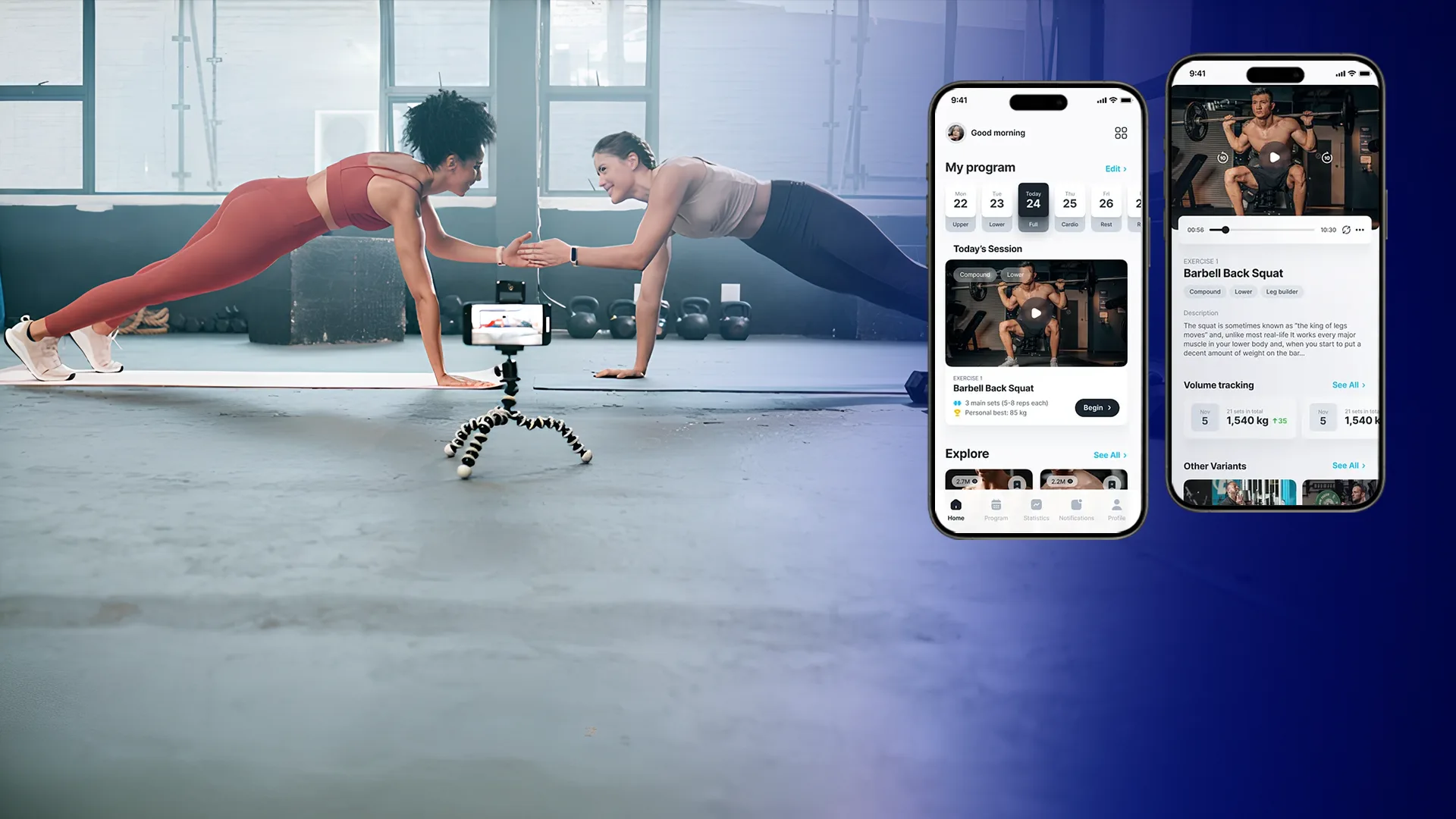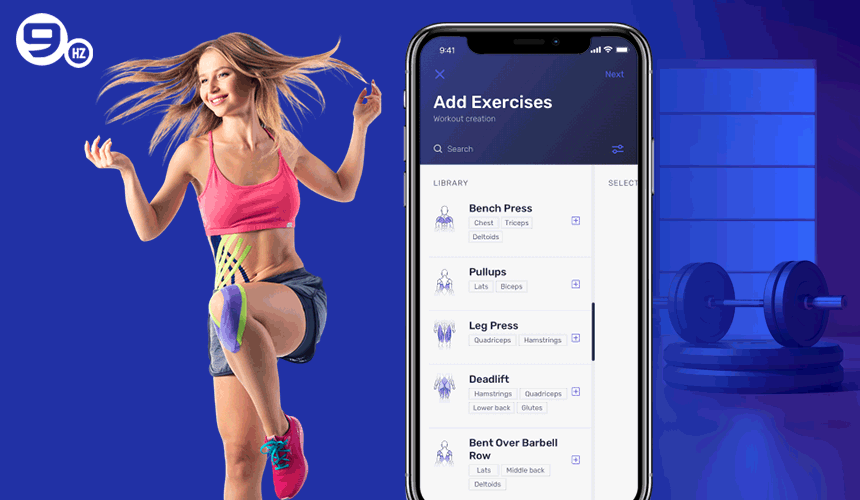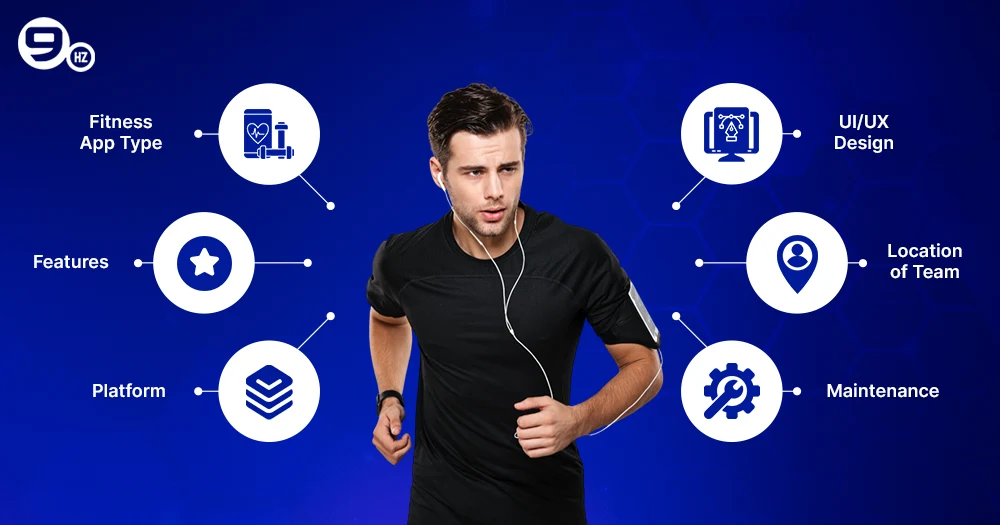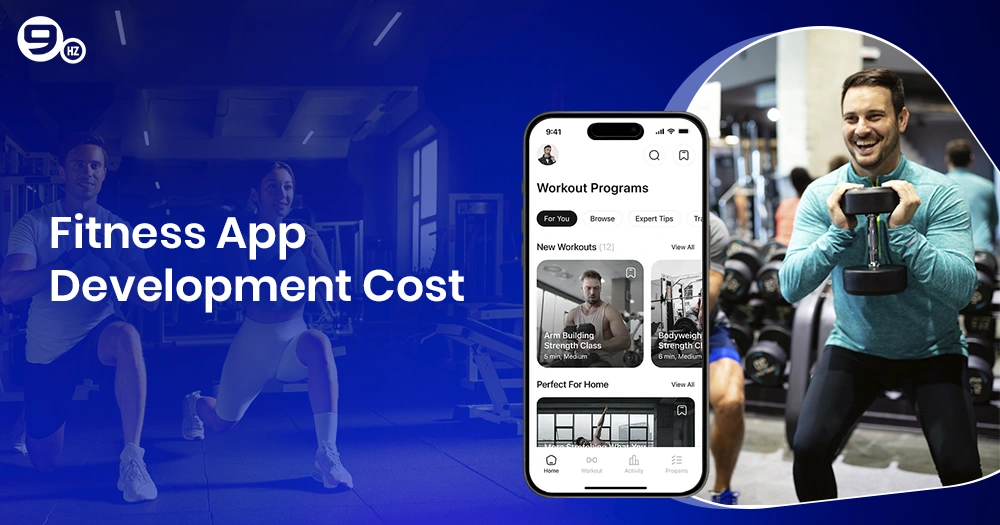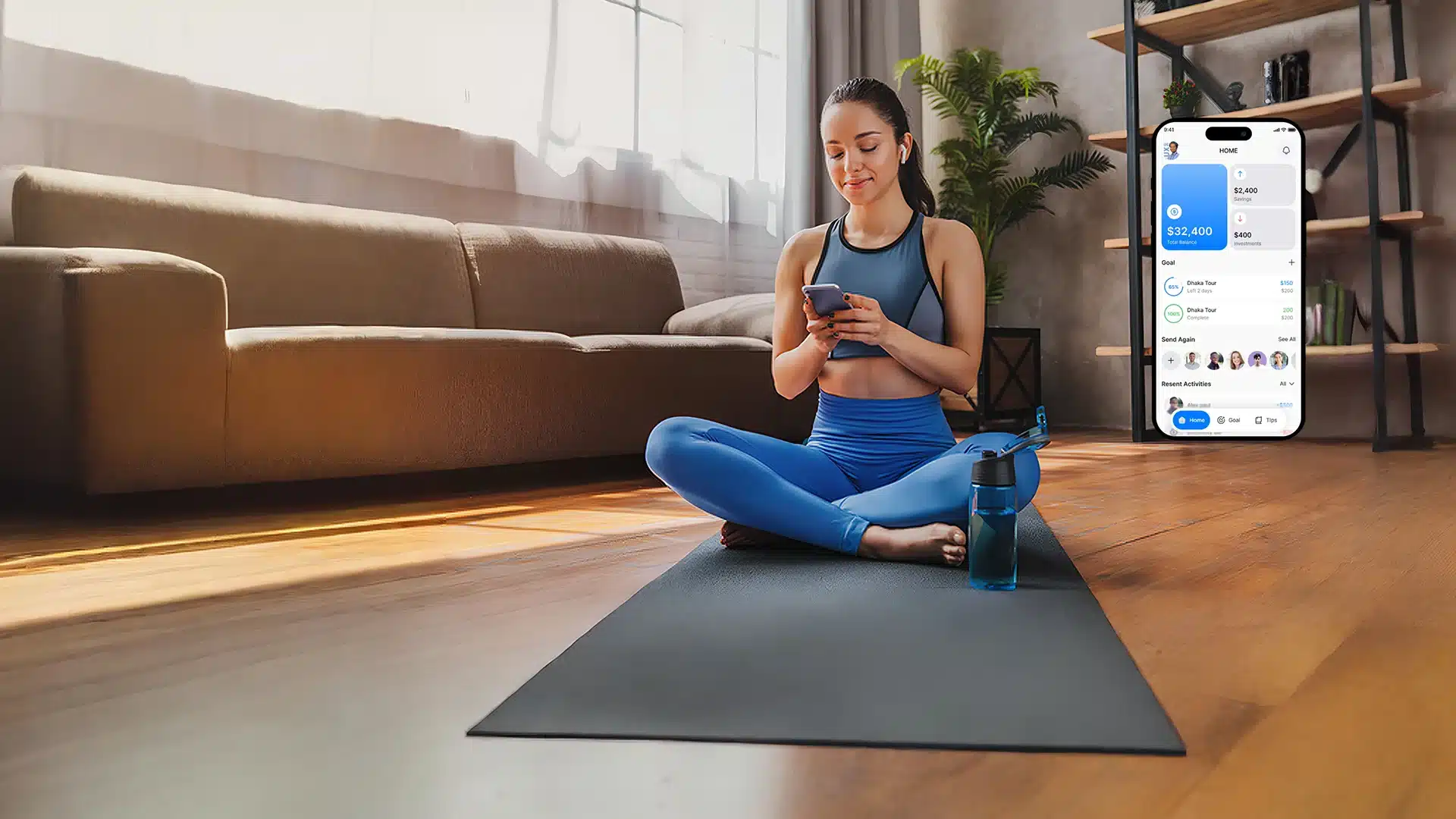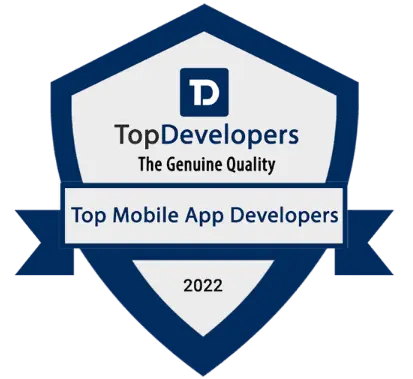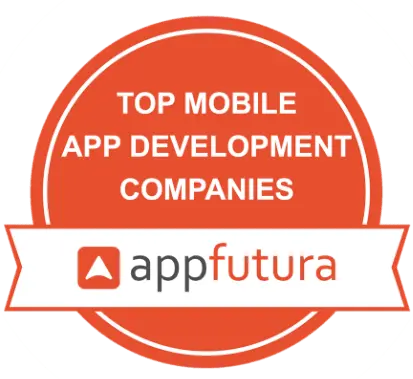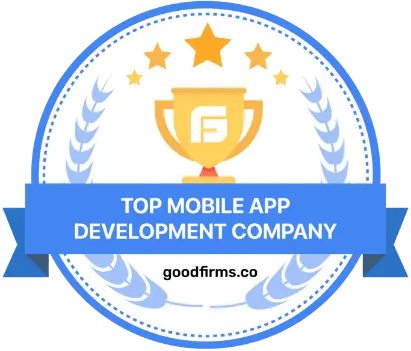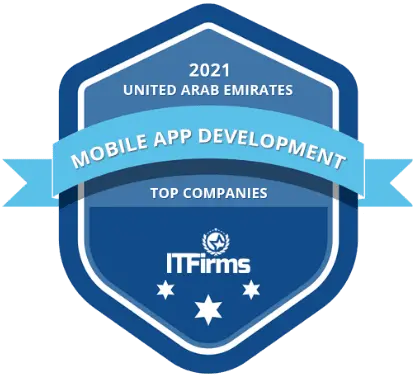Have you ever wondered why a few fitness apps are more successful than others—meaning they don’t just carve out a market; they evaporate? The answer is often less about creativity or engagement and more about the development investment.
The fitness app market is soaring, and the statistics back it up. According to Grand View Research, the fitness apps market was valued at $10.56 billion in 2024 and is projected to reach $39.35 billion by 2034. With users concerned about their health like never before, digital fitness solutions are no longer just a trend but are more of a personal and social health behavior shift.
Apps are changing how we operate our wellness journey away from the gym, whether it is in yoga sessions at home, meal plans from nutritionists, or AI-based personal training. Fitness apps like MyFitnessPal, Fitbit, and Nike Training Club are not just fulfilling an engagement purpose, they are increasing recurring revenue and establishing brand loyalty.
Imagine launching a sleek, functional fitness app that not only engages users but becomes their daily workout companion.
So here’s the interesting part: the cost to build a fitness app isn’t just a number, it’s part-funding and part-strategy. Cutting corners to launch the app quicker obviously makes it quicker, but it doesn’t do much for long-term success.
Let’s face it — as more startups, companies, and brands begin launching well-being (and fitness) tech, every delay in the app development process is just more time lost in a frankly already-competitive marketplace. While one is still planning who its target users will be, someone else might already be onboarding those users, and they are already establishing behaviours and habits related to tech wellness solutions.
So it’s no longer whether you should build a fitness app — it’s about whether you can carefully aim to build it right for the target cost and value. In this guide, we will attempt to cover the fitness app development cost in every way imaginable, including, what factors affect possible costs, how it varies for different types of apps, and — importantly — what tactics can help you build an important, useful, and quality app, while optimizing your budget. If you are looking for development team, The NineHertz is the leading fitness app development company.
Let’s get started.
What is a Fitness App?
A fitness app is a mobile application created to assist users in achieving their health and wellness objectives. Essentially, fitness apps provide digital solutions for things like workout planning, diet tracking, meditation, sleep improvement, etc. For people who are trying to lose weight, build muscle, stay active, or simply live healthier, fitness apps act as virtual wellness coaches—right in their pocket.
Types of Fitness Apps
There are many types of fitness apps, and the cost of developing a fitness app can vary greatly depending on the type of app you want to build. Here are the most popular types of fitness apps:
Workout and training apps:
These applications usually offer a structured workout regimen and often have videos of exercises. Examples include Nike Training Club and Freeletics.
Activity tracking apps:
Apps like Fitbit and Google Fit track activity (i.e. daily steps), calories burned, heart rate, sleep, and some can link to smart devices (i.e. wearable technology).
Diet and nutrition apps:
An example of this type of app is MyFitnessPal, which allows users to freely log meals, count calories, and track macros.
Meditation and yoga apps:
Examples of such apps are Headspace and Calm. They focus on mindfulness, breathing exercises, or yoga flows to help with stress relief.
Hybrid apps:
There are many apps that track both workouts and nutrition (and often other variables) or combine both fitness and wellbeing.
Pro Tip: To reduce total fitness app development cost, focus on one niche first and then expand.
Key Features of a Fitness App
Most successful fitness apps include the following core features:
- User Profiles and Goals
- Workout and Diet Plans
- Progress and Analytics Tracking
- Push Notifications and Reminders
- Including Wearable Devices (like Apple Watch or Fitbits)
- Social Sharing and Community Support
- Subscription or Payment Gateways
Not only do these features increase user engagement, but they also impact the total cost to create a fitness app, especially if implemented with additional customization.
A shift toward remote work since the COVID pandemic and increasing awareness about self-care have dramatically boosted fitness app usage. The Statista report provided insights into the global revenue of fitness apps crossing USD 5.3 billion in 2023 and rapid growth is expected to continue. This is a golden opportunity for businesses and startups as the demand is here now, but it is only for those who have properly prepared and are already in the market.
What if your app could be the reason why someone would start their fitness journey and stick with it? The market is here, but the question is – are you?
Convert Your App idea into Reality
7 Factors That Affect Fitness App Development Cost
If you’re curious about how one app can be built for $20,000 while another goes over $200,000, you are not alone. The cost to build a fitness app is not set in stone – it is subject to several moving parts. If you know what those parts are, you can plan better and avoid some surprises.
Let’s explore the 7 factors that will affect the cost to develop a fitness app:
1. Type of Fitness App
The type of app that you are building will have a sizable effect on the cost to make a fitness app. For instance:
- A basic app that counts calorie app will cost a lot less to develop than a fully featured fitness app with wearables integration, real-time personal training and video streaming.
- A hybrid app combining personalized workout plans, diet/personal tracking and social functions would naturally add additional screens and APIs, and hence a larger budget would be required.
Pro Tip: Get a viable solution with only the core feature to keep costs down. Then slowly add to it over time.
2. Features and Functionalities
The more advanced the features, the higher the development cost. While simple user registration, workout logs, and sending notifications are fairly simple features, advanced features such as AI-driven suggestions, connected devices, video-on-demand content, or real-time connections come with much more cost.
The most common premium features include:
- AI/ML-driven custom plans
- Live-streaming classes
- Gamification components
- Integration with smart devices
- AR/VR for immersive content
Each added feature portion of a new product increases the cost to develop a fitness app, especially when they come with their own backend logic or another third-party service.
3. Platform (iOS, Android, or both?)
Are you developing for iOS alone, Android, or both? Each platform has a different degree of development cost. Each native app will perform better, as opposed to building a cross-platform app in Flutter to save costs and time.
- Single platform: Lower initial investment
- Cross-platform app: Medium investment
- Two native apps: Highest investment
Your operating system, as well as how many, needs to be defined so you have a better idea of the cost to create a fitness app, as well as future maintenance costs.
4. UI/UX Design Complexity
The design of your app is not just about the aesthetics – it ultimately affects how often users return. An intuitive interface that is clean and easy to use is a very important segment to focus on. If you’re planning to use animation, 3D transition effects or custom illustrations, you can easily see your design costs shooting up.
A well designed fitness app will encourage users to engage every day, set goals and develop habits to achieve the fitness goals they set. So while the cost to create a fitness app goes up when you develop a good design, it is almost always a sound investment in the long run.
5. Location of Development Team
The location where your fitness app development team is based has a huge influence on the overall fitness app development cost. Here’s a quick comparison:
| Region | Hourly rate |
|---|---|
| North America | $100 – $200/hr |
| Western Europe | $70 – $120/hr |
| Eastern Europe | $40 – $80/hr |
| India/Southeast Asia | $20 – $50/hr |
Hiring an experienced team from a low-cost region like India can cut the fitness app development cost significantly without compromising the quality you expect.
6. Backend Development & Database Infrastructure
Your backend, when thinking of a mobile app, encompasses things like your data repository or storage, user management, analytics, content delivery, and everything else under the sun. Building a scalable, secure backend adds to the cost—especially if you’re planning for thousands of concurrent users.
Depending on the cloud platforms that are used (AWS or Firebase, etc), the initial setup and development costs may be minimal; however, the operational costs become monthly subscription fees.
Insider Tip: To help lower the infrastructure costs of your fitness app, try using a backend-as-a-service, also known as BaaS, in the beginning.
7. Maintenance and Updates
In reality, development will never stop after launch. The costs incurred for fixing bugs, developing new features, improving performance and complying with regulations will all be costs to be used and incorporated moving forward.
Generally, maintenance might cost around 15-20% of your total fitness app development costs each year.
Every decision, from platforms to features, shapes the final cost to make a fitness app. By understanding these 7 factors, you can better control scope, avoid bloated budgets, and build an app that users will love.
Cost to Make a Fitness App: According to the Types of Fitness Apps
The cost to develop a fitness app depends entirely on the type of app you want to create. Fitness apps can look very different from one another; they can be as simple as tracking activity to complete all-in-one wellness platforms. Each type of app requires a different level of features, integrations, and user experience, which can change the development cost of a fitness app.
Let’s take a look at the key categories and see what the cost to develop a fitness app usually looks like under each one.
| Type of Fitness App | Estimated Cost Range | Development Time | Complexity |
|---|---|---|---|
| Activity Tracker | $27,000 – $47,000 | 2–3 months | Low |
| Workout/Training App | $45,000 – $80,000 | 3–4 months | Medium |
| Diet & Nutrition App | $37,000 – $66,000 | 3–4 months | Medium |
| Yoga & Meditation App | $31,000 – $54,000 | 2.5–3.5 months | Medium |
| Hybrid Fitness App | $78,000 – $150,000+ | 4–6 months | High |
1. Activity Tracking Apps
Activity tracking apps are often the easiest to build and the cheapest to develop. Activity tracking apps sync with a wearable device and track physical metrics, for example, steps taken, calories burned, heart rate, sleep, etc. The development is so user-friendly since these apps only rely on health APIs and the Bluetooth integration for tracking with devices like Apple Watch or Fitbit.
Activity tracking apps include things like basic dashboards, real-time syncing, goal setting, and reminders. For a well-designed activity tracker, the cost to develop a fitness app of this kind typically ranges from $27,000 to $47,000, depending on the level of complexity and wearable integration of features.
2. Workout and Training Apps
Workout apps are designed for users who seek planned workout routines, virtual coaching, and training regimens. They frequently include a large selection of on-demand fitness videos (HIIT, weight training, yoga, etc.), customizable schedules, and audio assistance. Some apps also utilize AI to recommend workouts based on user preferences and history.
Since these types of apps involve a need for heavy video streaming infrastructure along with interactive UI, progress tracking, and potentially gamification, the cost to develop a fitness app in this category can range from $45,000-$80,000. Though these apps are going to take longer to develop, they can be quite engaging and monetized through subscriptions.
3. Diet and Nutrition Apps
Diet apps allow users to track what they eat, calculate calories, and track their macros. Some advanced apps provide AI-based meal recommendations, bar-code scanning of packaged foods, and provide healthy recipes. The rise in popularity of diet apps continues to grow as users are more aware of both fitness and nutrition.
The fitness app development cost for a nutrition tracker is likely to be between $37,000 and $66,000. Because of AI features, barcode libraries, and potentially a massive food database to be developed or licensed, the cost and time commitment will be a bit higher. However, these features increase user retention and the attractiveness of the overall experience.
4. Yoga and Mindfulness Apps
Yoga and mindfulness apps often blend physical health and fitness, along with mental health. They typically include guided yoga sessions, mindfulness, meditation or other relaxation practices or audio, breathing flows, construction of mindfulness, etc. Mindfulness and yoga apps always evoke a sense of calm and simplicity in the design, as well as create a clean and intuitive user interface.
As the app will usually include video or audio as well as cloud storage and “offline” capabilities, overall the cost to develop a yoga or mindfulness based wellness app tends to be in the range of $31,000 to $54,000. If these types of applications can integrate wearables or smart television devices into their user interface, the development costs can further increase.
5. Hybrid Fitness Apps (All-in-One)
Hybrid fitness apps are holistic end-to-end solutions for health and wellness. They have everything; workout tracking, video training, nutrition tracking, wellness, community, and more. Some apps add artificial intelligence (AI) for personalized coaching, gamification for motivation, and there is a growing number of wearables that track users in real-time as they exercise outside or in a group environment.
Due to the complexity of integrating multiple modules into the user interface, the cost to build a hybrid fitness app that has features similar to what was outlined above, will typically be in the range of $78,000-$150,000 or more! This type of app would be best suited for a well-established fitness brand or a heavily funded startup looking to offer a complete health experience for their end-user.
Choosing the right type of app is important, not only for cost planning but also for being in line with your target audience’s requirements. If you want to get started quickly with a smaller budget, then consider starting off with a focused app which may be a simple activity tracker or a yoga app. If your aim is to develop a fitness app with longevity based on high retention rate and monetization, then using a hybrid app may be worth its cost to develop a fitness app.
How Much Does it Cost to Make a Fitness App? (every stage-wise)
A complete understanding of the total fitness app development cost means analyzing the entire development lifecycle. Each phase of the development lifecycle, including research and planning, deployment, and maintenance, requires time, talent, and tools, and also contributes to the overall budget. As a fitness startup, whether your app is just a basic fitness tracker type of app or a feature-rich hybrid app, breaking down costs per phase helps you make good budget decisions and prevents surprises along the way. So let’s break down each stage along with data estimates for each stage of fitness app development.
| Development Stage | Estimated Cost Range |
|---|---|
| Discovery & Research | $2,000 – $5,000 |
| UI/UX Design | $4,000 – $10,000 |
| Frontend & Backend Development | $25,000 – $60,000 |
| Third-Party Integrations & APIs | $4,000 – $12,000 |
| Testing & QA | $3,000 – $8,000 |
| Deployment & App Store Launch | $1,000 – $3,000 |
| Post-Launch Support & Maintenance | $9,000 – $12,000 (yearly) |
1. Discovery and Market Research
The first stage of fitness app development is market research, i.e, identifying your niche, target audience, and competitors. This stage also includes user research, defining app goals, and developing an initial feature list from market demand for the app. You can also prepare a detailed product requirement document (PRD) and review competitive applications to find possible gaps to enter the market.
Though it may seem a small effort, market research could determine the success of your app. The total cost to create a fitness app in this context can range between $2000 to $5000, depending on the amount of research and use of external consultants.
2. UI/UX Design
Once you have determined the functional requirements, you can jump into UI/UX design. Designers typically work with wireframes, mockups, and clickable prototypes. Your designers will be able to visualize your app in layouts. Designing an app in the fitness space is crucial as users expect a seamless easy-to-navigate and motivational experience. The design phase is about refining the layout, placement of the buttons, the user flow, tone of the typography, and even the color palette, everything needs to be fitness user-friendly.
A visually pleasing, clean, fun, and easy-to-navigate design can help improve user retention significantly. In most cases, the fitness app development costs of this stage range from about $4,000 to $10,000, depending on the number of screens and complexity of the designs.
3. Front-End and Back-End Development
This is where you will do real app development as you will develop the front-end (what the users see), and back-end (servers, APIs, and databases) simultaneously. A fitness app needs to have features like user login, goals fitness, dashboards for progress, ability to video/audio stream, real-time syncing, and third-party API integrations like Google Fit, Apple HealthKit, and Fitbit.
If you have decided to go native, and want to develop a fitness app with an iOS counterpart and Android counterpart separately, your costs will likely be higher than using cross-platform frameworks like Flutter or React Native. For most fitness apps, your costs for this stage alone will be in the range of $25,000 – $60,000 minimum depending on the size and scope.
4. Third-Party Integrations & APIs
To provide users with a better experience, most fitness apps harness third-party APIs to pull in the level of detail an average user expects. This includes the main food calories API, step trackers, video hosting APIs, payment gateways, push notifications, and even integration with wearable devices, as well as synchronization across devices.
If you want to build a fitness app with robust third-party integration, the development costs can end up being anywhere from $4,000–$12,000 or more based upon the number and types of APIs used. Some services (like map or video services) may also have platform subscription or usage fees.
5. Testing and QA (Quality Assurance)
Prior to launching, it is critical to test the app to ensure the quality and performance are consistent on all supported devices and in all scenarios. From a testing perspective, a tester’s job is to go beyond bugs and find possible points of failure and examine checks to compatibility, usability, stress performance and security. Some gaps require validation against the app requirements and user flows.
Testing incorporates manual testing as well as tools, and the costs to make a fitness app will generally range between $3,000 – $8,000. Omitting or rushing this step in a project can be disastrous for initial reviews and ultimately a decline in the retention rates.
6. Deployment and Launch
Once you are ready to deploy your app to the Apple Store and Google Play Store, you will need to do the following – perform app store optimization, write metadata, upload app assets (screenshots, videos), and ensure that your app complies with app store policies. You will also likely need some legality, depending on the region and app store requirements, possibly a privacy policy or disclaimer.
Launching an app is not as expensive as developing one; however, it may cost from $1,000 – $3,000 for the supplementary fitness app development cost – all things considered. You will also have app store fees ($99/year to Apple, $25 one-time to Google).
7. Post-launch Support and Maintenance
The development work of the fitness app does not end at launch. In order to keep your users engaged and to stay competitive, regular bug fixes, updates, modifications, and server maintenance for your app will be required. There is a cost to maintain your app after the launch process to keep it viable, safe, and engaging for the long term.
Most fitness startups budget annually, around 15% – 20% of the initial development costs, for support and upgrading. If you spent $60,000 in total to build a fitness app, you might expect to budget around $9,000 – $12,000 annually for maintenance.
Every stage that is discussed above is important in designing the final result, and skipping any of them may increase the long-term cost of developing fitness apps owing to rework or performance difficulties. By carefully planning each phase, you can optimize resources and ensure that your investment results in a high-performing, user-loved application.
Ways To Reduce The Cost Of Creating A Fitness App
Creating a fitness app does not always have to be expensive. Through good planning and sound judgment, it is absolutely possible to reduce the cost to make a fitness app without sacrificing quality or experience for the end user. Whether you are a startup trying to get started on a shoestring budget or a fitness brand attempting to go digital, it is possible to set yourself up financially for success by using cost-effective practices as early in the process as possible. Here are proven ways to reduce the cost to develop a fitness app without cutting corners.
| Strategy | How It Helps Reduce Cost |
|---|---|
| Consider your MVP | Limits the development scope and validates the idea |
| Use Cross-Platform Development Frameworks | One codebase for iOS and Android |
| Use of Pre-Built Tools and APIs | Cuts development time and resources |
| Outsourcing to a Professional App Development Company | Avoids high in-house hiring and operational costs |
| Prioritize Features by User Value | Focuses the budget on high-value features |
| Opt for Cloud Services Instead of Building Infrastructure | The pay-as-you-go model eliminates upfront infrastructure costs |
| Do not Over-Engineering the First Version | Saves time and money in the initial version |
| Plan for Long-term Maintenance From Day 1 | Prevents expensive technical debt and downtime |
1. Consider your MVP (Minimum Viable Product)
One of the smarter ways to reduce the cost to create a fitness app is to launch with a Minimum Viable Product (MVP). An MVP only entails the most basic and essential features needed to solve the user’s problem; it does not include additional features, expanded functionality, or flashy add-ons. For example, if your fitness app was aimed at tracking daily steps and calories, your MVP could consist of the user login, goal setting, step tracker integration, and an overview/dashboard option to check the total in a less populated space.
When launching an MVP, you can minimize the development time and budget and can validate your app idea with real users. Once you have user feedback and know what features are gold, you can then update your app. You will save money and time because you will not develop unnecessary features.
Think of it as building the base of the house (MVP) before adding the paint and furniture.
2. Use Cross-Platform App Development Frameworks
Developing two separate native apps (one for iOS and one for Android) is highly cost consuming and could potentially double your fitness app development cost. A great way to cut your development budget is to use cross-platform technologies such as Flutter or React Native. The developer will write one codebase that will work across both platforms, saving a ton of time and money.
Native apps perform better and have unlimited customization of the user interface; however, the modern cross-platform tools and technologies are flexible and perform most of the functionality that would be required for fitness apps. Unless your app requires rock-star animated transitions and movements or features specific to either app (like “tap to call”), it is reasonable enough to create a fitness application using cross-platform technologies.
3. Use of Pre-Built Tools and APIs
Reinventing the wheel is not always necessary! There are many functionalities in a fitness app such as user authentication, notifications, analytics, and even payment gateway solutions, that are already available as plug-and-play modules or third-party APIs. These ready-to-use options can help you save on development time and cost to build a fitness app.
For example, Firebase can manage back-end infrastructure (like authentication and real-time database sync). Stripe or Razorpay can take care of the payments securely. You can integrate APIs, like Apple HealthKit or Google Fit, for instance, that allow you to track fitness without having to rely on developing it yourself. In fact, using pre-baked tools can give you a custom fitness app development time reduction of 30% – 40%.
4. Outsource to a Professional App Development Company
It takes a lot of time, resources and expenses to recruit designers, fitness app developers, testers, and project managers in order to have an in-house team. Compared to this, outsourcing can be a much cheaper way to go, especially if you are a startup. You can use an experienced healthcare mobile app development company, like The NineHertz, as a cheaper way to get the project done. Not forgetting that you will have access to skilled professionals with shorter turnaround times, flexible engagement models and lower overheads.
Many start-ups will even use an offshore company for development just to save close to 50% on the overall cost to get a new fitness app. Remember to always check the company’s portfolio, reviews from clients, and NDA obligations in order not to reduce the quality of your app or compromise your security.
5. Prioritize Features by User Value
It can be tempting to stuff your new app with all of the latest features you see inside a competitor app, and that can quickly lead to bloat and cost overrun. Instead, consider a feature-prioritization model such as the MoSCoW (Must have, Should have, Could have, Won’t have) method. It allows you to spend your time and money only on the features that are most needed by your users.
For example, video coaching or AI-based nutrition plans may sound like amazing additions to the overall app experience, but are probably not necessary for your first release. It will be important to at least have the basic features, such as goal tracking, reminders, and analytics and apply more premium extensions to your app once you attain user traction or have the available funding. This way, you can develop a more agile way to control your cost to make a fitness app, while also trying to establish some degree of user loyalty.
6. Opt for Cloud Services Instead of Building Infrastructure
Assembling your own backend infrastructure (servers, storage, security), can cost a lot of money upfront. There are cloud-based platforms such as AWS, Google Cloud or Microsoft Azure that allow developers to scale and in many cases, pay for only what is consumed, meaning the resources can grow with your user base.
Using cloud services will reduce the first-cost of building a fitness app as well as maintenance concerns since updates, uptime and security are all managed by the cloud services provider, each of which are large firms that capable of maintaining these requirements. Additionally, hosting via the cloud means you can scale seamlessly, which is critical when your app starts to become popular!
7. Do not Over-Engineer the First Version
Many app founders get stuck in a trap of over-engineering. For example, they may spend an excessive amount of time and money on perfecting every element before launching the first version. Always keep in mind- Perfection can wait. The purpose of your first launch is to add value to your users and get users, not to win the next design & UX award.
Keep interfaces clean, interactions clean and features useful. Avoid adding unnecessary animations, complicated user flows or an abundance of integrations. Focus on function first and then polish the application later in the life-cycle. Changing your mindset can significantly reduce fitness app development costs at launch.
8. Plan for Long-term Maintenance From Day 1
Most entrepreneurs have an idea of the cost to create a fitness app, but the cost of ongoing maintenance is often ignored. You should always budget for ongoing maintenance in the form of updates, bug fixes, performance updates, and many times, you may incur extra costs in the future if things go wrong. You can streamline future maintenance costs if you have well-designed, clean code and a well-documented, architecturally sound app.
Part of your maintenance must also include analytics so you can see which features users are more drawn to, and which you may want to simplify or remove in future updates. In the future, more features may offer the sustainability you are seeking, but having less to manage can also help you lower your cloud costs and enhance user experience.
Businesses who apply these principles can significantly reduce the overall cost of developing a fitness app while retaining functionality, usability, and user pleasure. The idea is to be strategic, start lean, and then scale depending on actual user behavior rather than preconceptions. Cutting corners might be detrimental to your business, but what about cutting fluff? That is just sensible development.
Why Choose The NineHertz for Your Fitness App Development?
The choice of the right development partner is of significant importance when creating a high-performing, scalable, and cost-effective fitness application. NineHertz is an award-winning fitness app development company that tailors solutions to meet your specific fitness and health app development business requirements and budget. NineHertz helps your app go from conception to launch, and into our sustainable future, utilizing our proven process, technology stack and client-centric workflows to enable your fitness app not only to perform but thrive in a competitive and sometimes saturated digital marketplace. Here is why you should partner with NineHertz to build your fitness app:
1. Expertise in the Fitness Domain and App Development Best Practices
NineHertz has experience in delivering incredibly robust fitness and health-based digital products. From calorie tracking apps, personal workout trainers, and fitness community platforms, we have a wealth of experience that spans user engagement, efficiencies in data accuracy, third-party integrations, and HIPAA/GDPR compliant considerations. Our expertise in these areas gives us the ability to produce feature-rich fitness applications that are both functional, secure, scalable, and user-centric.
With NineHertz’s expertise and knowledge in the fitness space, we can lower the risk of failing to meet user experience expectations, as well as deliver high-quality fitness applications that are cost-effective and entirely satisfactory.
2. Agile Engagement Models to Optimize Development Costs
Each business has its own budgetary limitations and expectations. As a result, we have developed several flexible engagement models to fit your needs—fixed price, hourly, and hiring a dedicated team. Whether you are a startup trying a new fitness concept or an enterprise scaling a solution, our goal is to keep the fitness app development cost in line with your budget.
Flexibility gives you complete control over the cost to develop a fitness app based on the engagement model that fits your financial and operational desires.
3. Full-Cycle Development Services Under One Roof
NineHertz provides full-cycle services for mobile app development from market research and UI/UX design to development, testing, testing, deployment, and post-launch support. Having everything under one roof means you have the convenience of not having to deal with multiple vendors, the added benefit of eliminating communication gaps, and keeping up with faster development cycles.
Having this one-stop-shop means you can save both time and investment and control the cost to create a fitness app without compromising quality.
4. Agile Methodology for Fast-Tracking Development
Time is money in the digital space. That’s why we utilize Agile methodology and ensure quick iterations, rapid feedback, and optimizing features almost in real-time. Our clients have been truly empowered by the level of communication they get with progress updates, sprint planning, and demo reviews.
This model is especially useful when looking to decrease the cost to develop a fitness app, as it allows the stakeholders to discover inefficiencies sooner, as well as to be able to pivot if necessary. Furthermore, we can prioritize what is important based on actual user needs—technology will help save you valuable resources!
5. Evaluate Advanced Technologies and Scalable Tech Stack
We utilize all of the latest (and greatest) tools and technologies to ensure that you get the longevity to your fitness application and the widest possible reach for performance on all devices. Whether it is AI-based workout suggestions, ML-required diet solutions, or IoT-enabled fitness wearables, NineHertz has your back!
We leverage a modern tech stack to deliver the best cost versus performance ratio and this will impact your fitness app costs!
| Functionality | Technology Stack |
|---|---|
| Front-End Development | Flutter, React Native, Swift, Kotlin |
| Back-End Development | Node.js, Django, Ruby on Rails, Laravel |
| Database | PostgreSQL, MongoDB, Firebase |
| Cloud Infrastructure | AWS, Azure, Google Cloud |
| Payment Integration | Stripe, Razorpay, PayPal |
| APIs and Wearables | Apple HealthKit, Google Fit, Fitbit APIs |
| Analytics & Reporting | Google Analytics, Firebase Analytics |
Note: Our strategic use of open-source technologies and APIs significantly helps reduce the cost to create a fitness app while maintaining performance.
6. Proven Track Record And Client Success Stories
NineHertz has launched over 1000 mobile apps for various industries, a number of which are fitness and wellness apps that have launched and scale globally. At NineHertz, we had startups, SMEs, and Fortune 500 clients—demonstrating our quality and commitment to innovation.
For example, we developed a fitness and diet tracking app for a European wellness brand that reduced customer onboarding by 40% (yes, that is a serious number) and the app scaled to over 250K users within the first year—at the same fitness app target development costs.
7. Post-Launch Support and Continuous Optimization
The relationship does not stop when you launch your fitness app; it acts as a preamble to your ongoing partnership with NineHertz. We can provide ongoing services you can rely on post-launch, including bug fixes, new feature additions, server monitoring, store cache clearing, app store optimisation, and lower prices than what other companies are doing. The objective is to continue to maintain the newest apps as best-of-breed and demonstrably reduce the costs you do not see on the outset.
Our focus will always be pre-emptive maintenance, so you can reduce future app costs by identifying bugs before they reach the public and routinely optimising performance.
8. Clear Pricing with No Surprises
Budget overages are among the number one fears of businesses building apps. At NineHertz, we believe in being transparent throughout the fitness app development process. From proposal to final invoice, we provide detailed pricing and ensure that you do not pay us more than agreed to, sometimes when building a fitness app, after which it can be hard to gauge the cost. This makes it easier for you to estimate and manage the cost to build a fitness app.
You’ll always know what you are paying for, and why.
If you are serious about mininzing the cost to make a fitness app and ensuring that it has the best potential, NineHertz is the business you can trust. Our all-inclusive, budget-wise pricing model allows you to receive not just any application but a long-lasting digital fitness product that evolves with your users and your business.
Conclusion: Fitness App Development Cost
In today’s world, consumers are becoming increasingly health-conscious and seeking out solutions to help them along their fitness journey that are convenient and personalized. The digital demand for fitness apps is at an all-time high, evidenced by the growing libraries of calorie trackers, yoga guides, personal trainers, health monitors linked to wearables, or whatever may be next in the digital fitness space. These applications have become an essential resource for millions of users globally. If you’re contemplating entering this incredibly lucrative market, it’s crucial to recognize the overall cost to make a fitness app, as this will shape your experience and allow you to make prudent choices.
Throughout this blog, we’ve discussed everything you need to know about the cost to make a fitness app, including what influences the pricing, how it varies by app type, and the key development stages that require budget planning. We also shared tips on how to manage and reduce the fitness app development cost by making smart decisions around features, technology, and development partners.
While this can be a complicated process, with a suitable approach, you can create an inspiring and low-cost app. Whether it’s a simple workout app or a complex training and nutrition app with wearables integration, your goal should always be to create an app that your users will love and use over time.
At NineHertz, we know how to create the balance between innovation and cost. We partner with clients to make sure each app we create meets their objectives, user expectations and financial constraints. If you would like to help bring your fitness app idea to life seamlessly and with clarity, we will walk you through the entire way.
In short, if you want to enter the fitness app industry with a solution that offers value, performance, and ROI, now is the time. And NineHertz is the team that can help you do it correctly.
FAQ’s on Cost to Make a Fitness App
Let us discuss some of the frequently asked questions regarding the cost to make a fitness app
Q1. How much does it cost to make a fitness app?
The cost to make a fitness app can range from $25,000 to $150,000 or more, depending on features, complexity, and development location.
Q2. What affects the fitness app development cost the most?
Key factors that affect the fitness app development cost are: the number of features, platform (iOS, Android, or both), UI/UX design, backend infrastructure, and third-party integrations.
Q3. How long does it take to develop a fitness app?
A basic fitness app may take 3–6 months, while a feature-rich version could take 8–12 months, depending on scope and team size.
Great Together!
